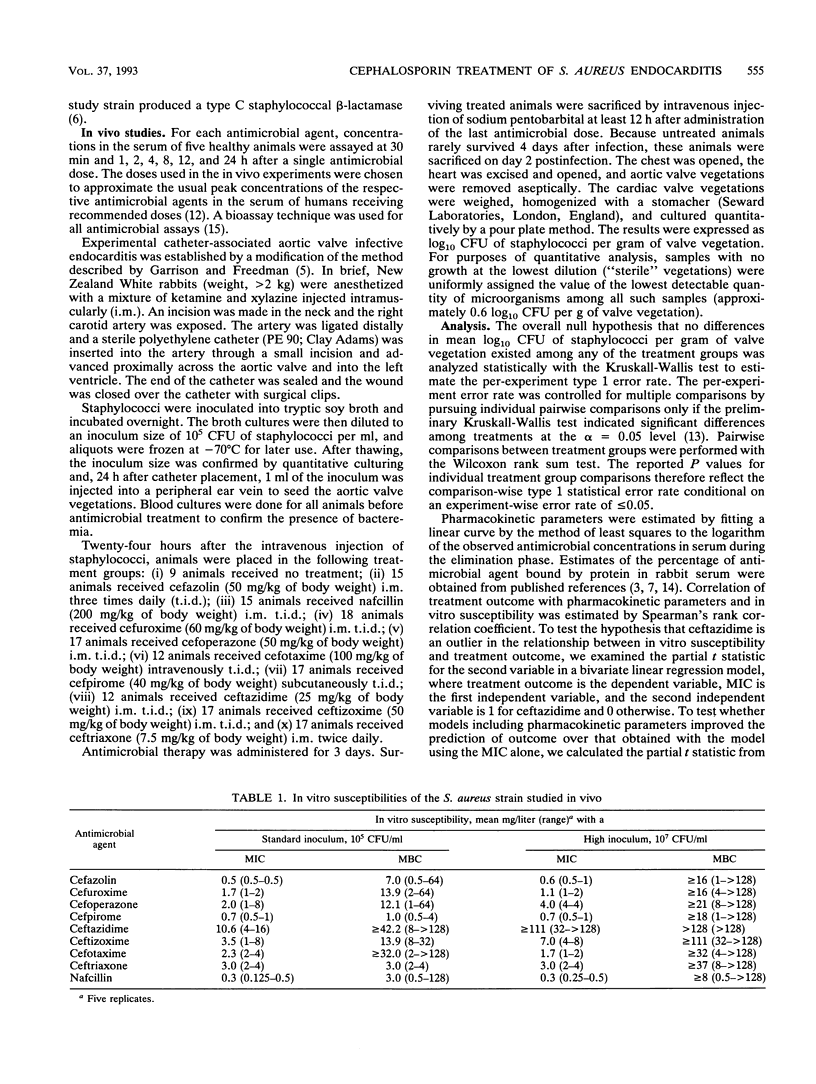Abstract
The effects of treatment with broad-spectrum parenterally administered cephalosporins and cefuroxime, cefazolin, or nafcillin were compared in an experimental model of Staphylococcus aureus infective endocarditis, and the results in vivo were compared with the activities of the study drugs in vitro. After 3 days of treatment, all antimicrobial agents tested were more effective than no treatment in reducing the number of surviving bacteria in cardiac valve vegetations. Nafcillin was the most effective agent studied and was significantly more active than was ceftizoxime, ceftriaxone, cefotaxime, cefoperazone, cefuroxime, or cefazolin (P < or = 0.05). Cefpirome and ceftazidime were the most effective broad-spectrum cephalosporins. The outcome of treatment with cefpirome or ceftazidime was similar to that of treatment with nafcillin and significantly better than that of treatment with ceftizoxime or cefotaxime (P < or = 0.05). Treatment outcome correlated closely with the MICs of the antimicrobial agents for the study strain with the exception of ceftazidime, which was significantly more active in vivo in comparison with other agents than predicted by its MIC (P < or = 0.0003). When ceftazidime was excluded as an outlier, treatment outcome correlated with the MICs of the remaining study drugs (Spearman's correlation coefficient, 0.95; P < or = 0.0004), as well as with the estimated percentage of time during which the concentration of total drug (correlation coefficient, -0.85; P < or = 0.007) or free drug (correlation coefficient, -0.90; P < or = 0.003) exceeded the MIC. A consideration of total or free drug concentrations in relation to MICs did not significantly improve the correlation with outcome observed with the MICs alone.
Full text
PDF




Selected References
These references are in PubMed. This may not be the complete list of references from this article.
- Baker R. L., Fass R. J. Correlation of in vitro activities of cephalothin and ceftazidime with their efficacies in the treatment of Staphylococcus aureus endocarditis in rabbits. Antimicrob Agents Chemother. 1984 Aug;26(2):231–234. doi: 10.1128/aac.26.2.231. [DOI] [PMC free article] [PubMed] [Google Scholar]
- Garrison P. K., Freedman L. R. Experimental endocarditis I. Staphylococcal endocarditis in rabbits resulting from placement of a polyethylene catheter in the right side of the heart. Yale J Biol Med. 1970 Jun;42(6):394–410. [PMC free article] [PubMed] [Google Scholar]
- Kernodle D. S., Stratton C. W., McMurray L. W., Chipley J. R., McGraw P. A. Differentiation of beta-lactamase variants of Staphylococcus aureus by substrate hydrolysis profiles. J Infect Dis. 1989 Jan;159(1):103–108. doi: 10.1093/infdis/159.1.103. [DOI] [PubMed] [Google Scholar]
- Klesel N., Seeger K. Pharmacokinetic properties of the new cephalosporin antibiotic HR 810 in animals. Infection. 1983 Nov-Dec;11(6):318–321. doi: 10.1007/BF01641356. [DOI] [PubMed] [Google Scholar]
- McColm A. A., Ryan D. M. Penetration of beta-lactam antibiotics into cardiac vegetations, aorta and heart muscle in experimental Staphylococcus aureus endocarditis: comparison of ceftazidime, cefuroxime and methicillin. J Antimicrob Chemother. 1985 Sep;16(3):349–358. doi: 10.1093/jac/16.3.349. [DOI] [PubMed] [Google Scholar]
- O'Brien P. C., Shampo M. A. Statistical considerations for performing multiple tests in a single experiment. 2. Comparisons among several therapies. Mayo Clin Proc. 1988 Aug;63(8):816–820. doi: 10.1016/s0025-6196(12)62363-5. [DOI] [PubMed] [Google Scholar]
- Washington J. A. In vitro testing of antimicrobial agents. Infect Dis Clin North Am. 1989 Sep;3(3):375–387. [PubMed] [Google Scholar]


